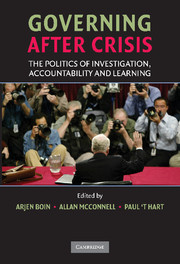Book contents
- Frontmatter
- Contents
- List of illustrations
- List of tables
- Contributors
- Introduction
- Part I Crisis-induced accountability
- Part II Crisis-induced policy change and learning
- 7 The 1975 Stockholm embassy seizure: crisis and the absence of reform
- 8 The Walkerton water tragedy and the Jerusalem banquet hall collapse: regulatory failure and policy change
- 9 Learning from crisis: NASA and the Challenger disaster
- 10 September 11 and postcrisis investigation: exploring the role and impact of the 9/11 Commission
- Conclusion
- Index
- References
9 - Learning from crisis: NASA and the Challenger disaster
Published online by Cambridge University Press: 04 June 2010
- Frontmatter
- Contents
- List of illustrations
- List of tables
- Contributors
- Introduction
- Part I Crisis-induced accountability
- Part II Crisis-induced policy change and learning
- 7 The 1975 Stockholm embassy seizure: crisis and the absence of reform
- 8 The Walkerton water tragedy and the Jerusalem banquet hall collapse: regulatory failure and policy change
- 9 Learning from crisis: NASA and the Challenger disaster
- 10 September 11 and postcrisis investigation: exploring the role and impact of the 9/11 Commission
- Conclusion
- Index
- References
Summary
Introduction: did NASA learn from the Challenger disaster?
On 1 February 2003, the Columbia Space Shuttle disintegrated during the final stages of its return flight to earth. The drama unfolded live on television: spectacular pictures of the doomed flight were punctuated by reactions of devastation and loss. It was in some ways a familiar drama. Seventeen years before (28 January 1986), Space Shuttle Challenger had exploded within 2 minutes of its launch. The Challenger disaster was etched in the minds of an entire generation of American schoolchildren, who watched the launch in their classes (the teacher Christa McAuliffe was on board to teach elementary school students from space).
Both disasters were studied by a presidential commission. Both commissions were scathingly critical of the National Aeronautics and Space Agency (NASA). The Rogers Commission, which studied the causes of the Challenger disaster, criticised the space organisation for not responding adequately to internal warnings about the impending disaster. The Columbia Accident Investigation Board (CAIB) found that little had changed since the Challenger disaster: ‘By the eve of the Columbia accident, institutional practices that were in effect at the time of the Challenger accident – such as inadequate concern over deviations, a silent safety programme, and schedule pressure – had returned to NASA’ (CAIB 2003: 101). The inescapable conclusion emerging from the CAIB report is that NASA failed to learn the obvious lessons flowing from the Challenger disaster, which caused the demise of Columbia (see, e.g. Vaughan 2005).
- Type
- Chapter
- Information
- Governing after CrisisThe Politics of Investigation, Accountability and Learning, pp. 232 - 254Publisher: Cambridge University PressPrint publication year: 2008
References
- 10
- Cited by



